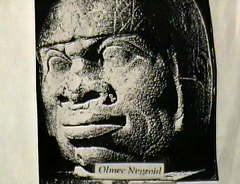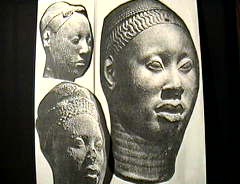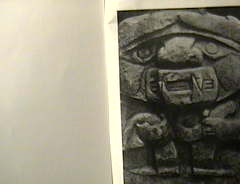staticshock
Veteran
BLACK CIVILIZATIONS OF
ANCIENT AMERICA (MUU-LAN),
MEXICO (XI)
Gigantic stone head of Negritic African
during the Olmec (Xi) Civilization
By Paul Barton
The earliest people in the Americas were people of the Negritic African race, who entered the Americas perhaps as early as 100,000 years ago, by way of the bering straight and about thirty thousand years ago in a worldwide maritime undertaking that included journeys from the then wet and lake filled Sahara towards the Indian Ocean and the Pacific, and from West Africa across the Atlantic Ocean towards the Americas.
According to the Gladwin Thesis, this ancient journey occurred, particularly about 75,000 years ago and included Black Pygmies, Black Negritic peoples and Black Australoids similar to the Aboriginal Black people of Australia and parts of Asia, including India.
Ancient African terracotta portraits 1000 B.C. to 500 B.C.
Recent discoveries in the field of linguistics and other methods have shown without a doubt, that the ancient Olmecs of Mexico, known as the Xi People, came originally from West Africa and were of the Mende African ethnic stock. According to Clyde A. Winters and other writers (see Clyde A. Winters website), the Mende script was discovered on some of the ancient Olmec monuments of Mexico and were found to be identical to the very same script used by the Mende people of West Africa. Although the carbon fourteen testing date for the presence of the Black Olmecs or Xi People is about 1500 B.C., journies to the Mexico and the Southern United States may have come from West Africa much earlier, particularly around five thousand years before Christ. That conclusion is based on the finding of an African native cotton that was discovered in North America. It's only possible manner of arriving where it was found had to have been through human hands. At that period in West African history and even before, civilization was in full bloom in the Western Sahara in what is today Mauritania. One of Africa's earliest civilizations, the Zingh Empire, existed and may have lived in what was a lake filled, wet and fertile Sahara, where ships criss-crossed from place to place.
ANCIENT AFRICAN KINGDOMS PRODUCED
OLMEC TYPE CULTURES
The ancient kingdoms of West Africa which occupied the Coastal forest belt from Cameroon to Guinea had trading relationships with other Africans dating back to prehistoric times. However, by 1500 B.C., these ancient kingdoms not only traded along the Ivory Coast, but with the Phoenicians and other peoples. They expanded their trade to the Americas, where the evidence for an ancient African presence is overwhelming. The kingdoms which came to be known by Arabs and Europeans during the Middle Ages were already well established when much of Western Europe was still inhabited by Celtic tribes. By the 5th Century B.C., the Phoenicians were running comercial ships to several West African kingdoms. During that period, iron had been in use for about one thousand years and terracotta art was being produced at a great level of craftsmanship. Stone was also being carved with naturalistic perfection and later, bronze was being used to make various tools and instruments, as well as beautifully naturalistic works of art.
The ancient West African coastal and interior Kingdoms occupied an area that is now covered with dense vegetation but may have been cleared about three to four thousand years ago. This includes the regions from the coasts of West Africa to the South, all the way inland to the Sahara. A number of large kingdoms and empires existed in that area. According to Blisshords Communications, one of the oldest empires and civilizions on earth existed just north of the coastal regions into what is today Mauritania. It was called the Zingh Empire and was highly advanced. In fact, they were the first to use the red, black and green African flag and to plant it throughout their territory all over Africa and the world.
The Zingh Empire existed about fifteen thousand years ago. The only other civilizations that may have been in existance at that period in history were the Ta-Seti civilization of what became Nubia-Kush and the mythical Atlantis civilization which may have existed out in the Atlantic, off the coast of West Africa about ten to fifteen thousand years ago. That leaves the question as to whether there was a relationship between the prehistoric Zingh Empire of West Africa and the civilization of Atlantis, whether the Zingh Empire was actually Atlantis, or whether Atlantis if it existed was part of the Zingh empire. Was Atlantis, the highly technologically sophisticated civilization an extension of Black civilization in the Meso-America and other parts of the Americas?

Stone carving of a Shaman or priest
from Columbia's San Agustine Culture

An ancient West African Oni or King holding similar artifacts
as the San Agustine culture stone carving of a Shaman
The above ancient stone carvings (500 t0 1000 B.C.) of Shamans of Priest-Kings clearly show distinct similarities in instruments held and purpose. The realistic carving of an African king or Oni and the stone carving of a shaman from Columbia's San Agustin Culture indicates diffusion of African religious practices to the Americas. In fact, the region of Columbia and Panama were among the first places that Blacks were spotted by the first Spanish explorers to the Americas.
From the archeological evidence gathered both in West Africa and Meso-America, there is reason to believe that the African Negritics who founded or influenced the Olmec civilization came from West Africa. Not only do the collosol Olmec stone heads resemble Black Africans from the Ghana area, but the ancient religious practices of the Olmec priests was similar to that of the West Africans, which included shamanism, the study of the Venus complex which was part of the traditions of the Olmecs as well as the Ono and Dogon People of West Africa. The language connection is of significant importance, since it has been found out through decipherment of the Olmec script, that the ancient Olmecs spoke the Mende language and wrote in the Mend script, which is still used in parts of West Africa and the Sahara to this day.
Via: RaceandHistory.com - BLACK CIVILIZATIONS OF ANCIENT AMERICA
Debunking clyde winter on Shang, Olmec, Egyptian, Khmer civilization - Historum - History Forums
Stop it fam. Let other cultures have their own shyt & stop being a vulture.
Mexicans & hispanics are related & look like those from Central Asia without the slanted eyes.









